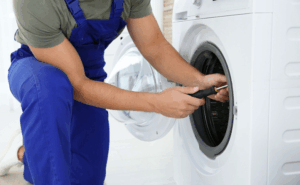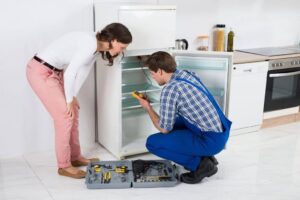The holidays move fast, and your kitchen needs to keep up. A finicky range can turn joyful cooking into stress, so let’s get ahead of it today. This blog shares quick fixes and smart checks you can do in under an hour. We’ll flag what’s safe to DIY and what deserves a pro. If you’re in Orange County, you’ll also see when range stove repair services make the most sense—before guests arrive, not after the roast goes cold.
Start With Safety and Power Checks
Before touching a knob, ensure your range is safe. Unplug an electric range; shut the gas valve for a gas unit. Now confirm the basics, because minor issues often hide in plain sight. Is the outlet firm? Do the lights on the control panel turn on? If they flicker, a loose plug or tripped breaker might be the culprit. For gas, ensure the shutoff valve handle is parallel with the pipe (open). Finally, sniff for gas; if you smell rotten eggs, ventilate the area, leave immediately, and call your gas company or a technician.
Quick “Power First” Checklist
- Reset the kitchen breaker; test the outlet with another device.
- Reseat the plug; avoid extension cords.
- Confirm the gas valve is fully open.
- Check that the child lock or demo mode isn’t on.
Clean What Actually Affects Cooking
A clean range doesn’t just look good—it works better. Food debris blocks airflow and burner ports, causing flames to become weak or uneven. Meanwhile, baked-on grease acts like insulation in the oven, which stretches preheat times. Remove grates and burner caps; soak them in hot, soapy water. Use a soft brush on burner ports; avoid using toothpicks, as wood can snap inside. For electric coil elements, wipe gently once cool; never immerse them. Inside the oven, scrape significant bits first, then use a non-abrasive cleaner. You’ll smell less smoke during preheat and, therefore, enjoy more consistent heat.
Fix Burners That Won’t Ignite
No spark? Let’s walk through causes and fixes. On gas burners, a visible spark should click at the igniter tip. If there’s clicking but no flame, the ports may be clogged; realign the cap, because a crooked cap misdirects gas. If there’s no click at all, inspect the igniter for cracks or grease build-up. Clean it with a cotton swab and rubbing alcohol. On electric smooth tops, a dead zone often points to a failed element or a faulty switch. You can test continuity with a multimeter; however, consider calling a range stove repair service if you’re not comfortable with electrical work.
Get Oven Temps Back on Track
Undercooked pies and overbaked rolls usually trace back to calibration issues. Calibration means telling the oven to adjust its baseline temperature up or down to match reality. First, place an oven thermometer in the center rack and preheat to 350°F. Let it cycle for 15–20 minutes, then check the reading. If you’re consistently off by 15–25°F, use your control panel or user manual to recalibrate. Some ranges allow you to add or subtract degrees in small increments. If temperatures swing wildly, your temperature sensor or thermostat may be failing, and a pro visit will save you time (and the turkey).
Stop Strange Smells and Smoke
New smells aren’t usual—but they’re not always bad news. Smoke at preheat often indicates that leftover grease is burning off. Finish a thorough clean, then run the oven empty at 400°F for 20 minutes to clear any residue. If you notice a sharp chemical odor, remove foil from the oven floor because it blocks airflow and can scorch. A lingering gas smell, however, is different. Open windows, avoid switches, and step outside to call for help immediately. When odors persist after cleaning and a burn-off cycle, range stoverepair servicescan inspect gaskets, insulation, and venting so your kitchen stays comfortable.
Quiet the Clicks and Noises
Some sounds are normal; others hint at trouble. Rapid clicking from a gas burner usually means moisture on the igniter—common after cleaning. Dry the area thoroughly and try again. A low, steady hum may come from cooling fans or convection blowers; that’s fine. However, scraping or rattling from inside the oven could be a warped fan blade or a loose heat shield. Tighten visible screws you can safely reach once the appliance is cool. If noise returns, document where and when it happens. That note helps a technician diagnose faster and, therefore, gets you back to cooking sooner.
Know What to DIY vs. Call In
You can fix a lot with a brush, a thermometer, and patience. But some jobs call for training and proper parts. Use this quick guide as you plan your weekend tune-up.
Gas vs. Electric: Fast Holiday Checks
| Item to check | Gas range quick step | Electric range quick step |
| Power | Verify spark; dry igniter | Confirm outlet and breaker |
| Heat issue | Clean burner ports | Test element continuity |
| Odors/smoke | Burn-off cycle; vent well | Remove foil; clean residue |
If you hit repeated error codes, smell gas, or see heating elements blistering, stop. Booking range stoverepair services at this point protects your appliance and your timeline.
Speed Up Preheat and Cooking Times
Holiday meals juggle sides, mains, and dessert. Minor tweaks make a big difference. Use the correct rack position (center for most baking, higher for browning). Preheat with cookware inside for thick pans, because it shortens warm-up lag. Avoid opening the door frequently; every peek dumps heat and adds minutes. For gas ovens, keep the broiler area clean to maintain strong airflow. In electric ovens, verify that both the bake and broil elements glow during preheat; if only one does, performance drops, and a repair may be necessary. These habits keep dinner moving, even when the oven is full.
Build a Simple Holiday Maintenance Routine
Prevent problems before the big day. After each heavy cook, wipe spills once the oven cools; sticky sugars carbonize and smoke later. Each month, remove and wash burner grates and caps. Check door gaskets for tears; heat leaks make the oven run longer and dry out food. Twice a year, vacuum dust from the back panel area (unplug first). And a week before hosting, run a test bake with your thermometer. If temps are off or a burner misbehaves, you’ll have time to schedule range stove repair services and avoid a last-minute scramble.
When Time Is Short, Call a Pro
You’re juggling guests, groceries, and travel plans. If your oven won’t hold temp, a burner won’t light, or you suspect a sensor failure, bring in help. A trained tech can diagnose electrical faults, replace igniters, or recalibrate controls quickly. Meanwhile, you can prep sides and desserts with confidence. Keep model and serial numbers handy (usually inside the door frame) and note any symptoms, including noises, smells, error codes, and the times they occur. Precise, simple details shorten the visit and, therefore, reduce downtime. For many households, range stove repair servicesbecome the fastest route to a smooth holiday meal.
Cook Happy, Not Stressed
Your range doesn’t need to be perfect—it needs to be ready. Start with safety checks, clean the parts that matter, verify oven temperature, and listen for warning sounds. If anything still feels off, don’t gamble with the big meal. A quick call to a trusted technician keeps your plans on track. And if you’re local, range stove repair services are just around the corner. Need a friendly hand before the big day? Reach out to Complete Appliance Repair—we’ll help you get dinner on the table, warm, on time, and without the drama.







